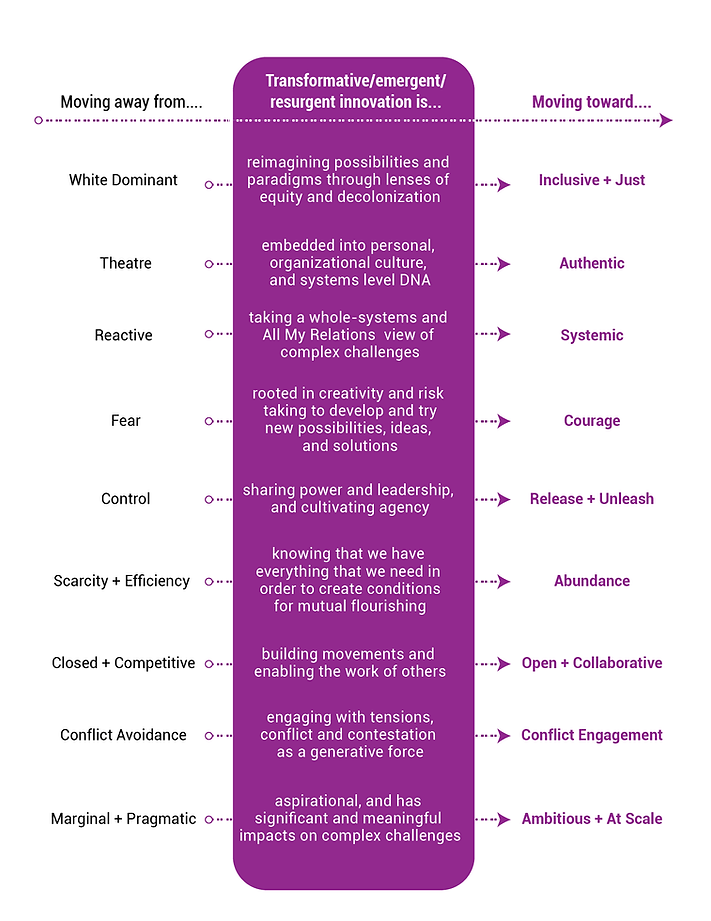
THEORIZING PUBLIC SECTOR INNOVATION
What Is It?
There is currently a proliferation of ‘innovation’ initiatives in the public sector. Innovation is a fuzzy word that is widely used in this context, yet rarely defined and described clearly in practice.
Some innovations are about improving customer experiences, and others are concerned with digital transformation. Some innovation efforts are about transforming systems, and others are focused on co-creation with those outside government. All of these approaches can be called ‘innovation’, but there are very different understandings of how change happens nested within these approaches.
Stronger theorization of what we mean by innovation is necessary so that we can make choices, get explicit, and be articulate about what we do and do not mean when we practice innovation. When innovation initiatives more strongly theorize what we do, the learning, movement-building potential, and lasting changes from our work will be much more significant. This foundation supports thoughtful and strategic choice-making about the paradigms, theories, and thinking about what innovation actually means.
Orientations to Innovation
Change happens through incremental adaptations. The foundations of the current system remain unquestioned and unchanged, and the focus is on making things work better through small improvements. Change looks like skills building and horizontal development at the personal level, and efficiency-type improvements at the organizational and systems levels.

Transformation is a more significant shift in people, structures, processes and systems. It is often triggered by a growing problem, challenge, or crisis, and this pressure is what is required in order to shift or dislodge a stable or stuck approach into a different state. At the personal level, this looks like moving up a stage in vertical development, and may mean reframing goals, roles, or structure of an organization or system. Both change and transformation modify, respond to, and/or adapt existing elements, processes, structures, behaviours and routines. They are path dependent, meaning that the change or transformation is dependent on the history of what has come before, as well as on whatever it was that triggered it. The result of the change or transformation is predetermined by the existing state of the person, organization, or system.
Emergence is a dissimilarity (rather than a difference), where the parameters themselves change, rather than the variation of existing parameters that happens with change or transformation. Emergence is creation sparked by aspiration, the ‘becoming’ of a vision for a new opportunity that was not there, or not seen, before. Emergence tends to vastly expand the potential, capacity, and capability of people, organizations and systems to work on the challenges that they face.
Resurgence is catalyzed by work to recover and revitalize possibilities of being and relationship that have been suppressed and marginalized by the dominant system. Resurgence is most often associated with Indigenous cultures, and that is where the most important theorizing of resurgence has been taking place. As Jeff Corntassel observes, “processes of resurgence are often contentious and reflect the spiritual, cultural, economic, social and political scope of the struggle.” This figure describes elements of a transformative, emergent, and/or resurgent approach to innovation in the form of what we need to move away from, and what we need to move toward.
How to Theorize Innovation
This is a tool to aid strategic thinking and choice-making early in an innovation effort, as well as in evaluation, reflection, and learning processes. The goal of this framework is to surface the choices that are being made when defining “innovation”, and to provide a structure to question the underlying and often unstated assumptions, values, and ambitions of these initiatives. The aim is to contribute to more effective innovation initiatives in the public sector by taking a stronger approach to theorization.
For printer settings, click here

This foundation can be used in a variety of ways, both dialogically as well as by individuals. The key idea is to really wrestle with understanding and choice-making about the type of innovation effort you are undertaking. Dig into what these words mean, and understand what the real differences are between these choices. Get rigourous and clear about your ideas and approaches, and how these choices then translate into your process design and use of tools and techniques.
A blank template is provided, with the idea that each of the petals and sub-petals are shaded with a level of saturation that represents the extent to which each particular element of this framework is part of your approach to innovation, while drawing from the distinctions between change, transformation, emergence, and resurgence. If there are other approaches to innovation that aren’t on this framework feel free to add them, and to let us know what you’ve added or changed so we can improve this over time.
Source:
This framework was generated through participatory action research with 85 co-researchers from 25 organizations in 7 countries, and was gathered up and crafted through Lindsay Cole’s Ph.D. research. More about this can be found here.